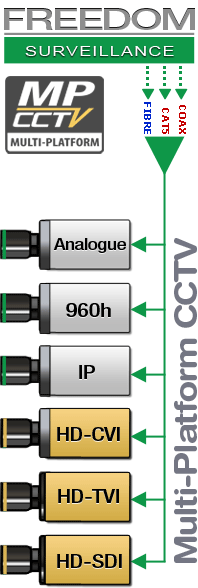What is HD-SDI?
High Definition Serial Digital Interface (HD-SDI), also known as the SMPTE 292M standard, is an interface standard that allows the transmission of high definition video over coaxial cable at speeds of around 1.485 Gbit/s. The cable length will vary depending on the quality of the video you require and the quality of the cable used. The maximum cable length for HDcctv™ 720p and 1080p standard is 100 metres. If you do not require HD resolutions, cable lengths can be up to 300metres can be used. This broadcast television technology has been technically proven through application in television studios worldwide since the late 1990's.
Although HD-SDI is new to video surveillance applications, HD-SDI has been around for many years in Television broadcast production), the high cost is what has kept HD-SDI out of the mainstream. This is now changing with more manufacturers producing SDI equipment at a more competitive price. Since many organizations have existing coaxial based analogue CCTV networks, the upgrade path to High Definition CCTV will be less expensive by utilizing HD-SDI technology rather than IP.
HD-SDI has the potential to solve many common issues associated with both conventional analogue CCTV and IP based systems, some of these being scalability to High Definition and implementation complexity and cost. It's still early days for HD-SDI, hardware availability is improving.
HD-CVI (NEW)
HD-CVI is a similar to HD-SDI, but delivers on many of the promises promoted by the other 'HD-SDI' based CCTV technologies. HD-CVI stands for High Definition Composite Video Interface, it is a CCTV transmission technology that allows high definition video to be transmitted over a coaxial cable of lengths up to 500 metres @ 720p and 300 metres @ 1080p with little or no latency.
HD-CVI modulates video signals, transmitting a base-band and quadrature amplitude modulation. HD-CVI avoids cross talk of CVBS and completely separates the brightness signal & hue signal, to enhance video quality. HD-CVI comes in two versions 1920H (1920×1080) and 1280H (1280×720) resolutions; which are compatible with 1080p & 720p.
HD-CVI also allows multiple-signals to be transmitted over one COAX cable, both audio signals and 2-way data communication signals are embedded in a blanking zone, which enhances the synchronization with the video signal; and supports a 44.1kHz sampling rate. The forward and reverse data channels in the frame blanking zone, allow for two-way end-to-end transmission to support control features like camera configuration, camera focus, PTZ control and alarm sending all over a single COAX cable.
The price of HD-CVI systems compared to old SD analogue systems is almost the same, and therefore this technology is likely to replace traditional SD analogue systems.
The upgrade path to HD-CVI allows you to keep your existing COAX cabling and replace only the recorder/s and cameras. If you are using a Multi-Platform VMS software like Freedom VMS™, this upgrade can be transitional as budgets become available, you could have a mix of SD analogue system/s and HD-CVI system/s at the same site, managed under one software platform.
HDcctv™
HDcctv™ is a CCTV interface standard that utilizes HD-SDI technologies specifically for use in Video Surveillance. HDcctv™ is a standard that derives from a set of standards, including SMPTE-292M, developed by the Society of Motion Picture and Television Engineers for application in broadcast television studios.
UPDATE The new version of the HDcctv™ standard (V2.0 AT) is based on HD-CVI, so will inherit the features of HD-CVI technology
Benefits of HD-SDI technologies
- Works with existing coaxial cabling
- Near zero latency - Very smooth motion
- No network configuration or modification needed
- Recording is immune to IP network interruptions
- Less complex than IP based systems
HD-TVI (NEW)
HD-TVI (High Definition Transport Video Interface) is the latest in line of HD over coax technologies. Very similar to HD-CVI but is not expected to be compatible. This technology is expected to be officially released at the end of 2014.
Benefits of HD-SDI technologies
- Works with existing coaxial cabling
- Near zero latency - Very smooth motion
- No network configuration or modification needed
- Recording is immune to IP network interruptions
- Less complex than IP based systems
Drawbacks and considerations for HD-SDI
Poor quality coaxial cables can affect HD-SDI performance. Newer HD-CVI is now more forgiving that HD-SDI when it comes to bad quality cabling.
HD-SDI cameras cannot be used directly for edge storage. Current CCTV HD-SDI standards only allow for 720p, 1080p (1920x1080 pixels) resolutions whereas some IP cameras can support resolutions of over 10Mega pixels (3648x2752 pixels) and higher.
With the exception of HD-CVI & HDcctv V2.0 AT, configuration of HD-SDI cameras must be performed physically at the camera, which can make maintenance more tedious and time consuming.
Transitional Upgrading
HD-SDI technologies offer a great path for transitional upgrading to higher definition video image quality. This can be done in stages. For example you may have a 40 camera system, instead of replacing all your cameras at once with HD-SDI cameras, you can start with a 4 camera HD-CVI system covering the areas you consider the most important and gradually replace all your analogue cameras with HD-CVI cameras thus spreading the cost of upgrading over a longer period.

